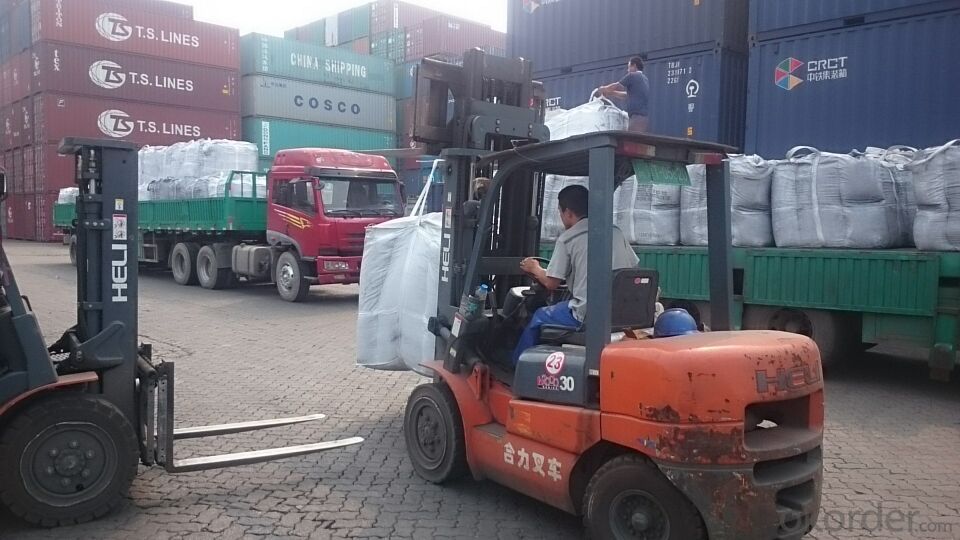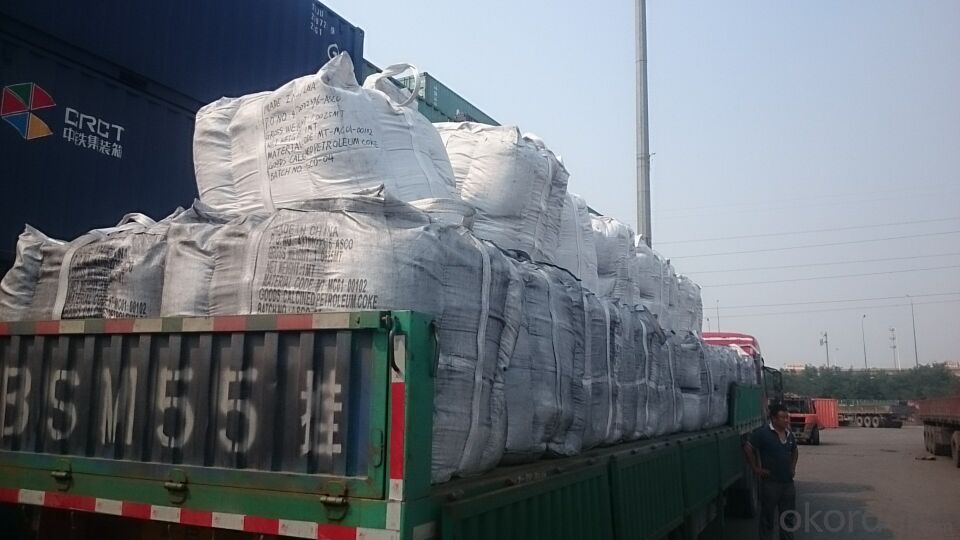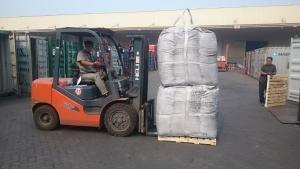Graphite Petroleum Coke with lower Sulphur0.03% max in Low VM
- Loading Port:
- Tianjin
- Payment Terms:
- TT OR LC
- Min Order Qty:
- 21 m.t.
- Supply Capability:
- 5000 m.t./month
OKorder Service Pledge
OKorder Financial Service
You Might Also Like
Introduction:
GPC has good characteristics with low ash, low resistivity, low sulphur, high carbon and high density. It is the best material for high quality carbon products. It is used as carbon additive in steel industry or fuel.
Features:
1.Our strong team provide you reliable service that make you feel purchasing is more easier
2. We ensure that we can supply capability with competitive price.
3. Work strictly to guarantee product quality,
4. Highest standard of integrity. Guarantee customer's benefit.
5. Supplying Pet Coke, Met coke, Foundry Coke, Carbon Raiser etc.
Specifications:
F.C.% | 95MIN | 94MIN | 93MIN | 92MIN | 90MIN | 85MIN | 84MIN |
ASH % | 4MAX | 5MAX | 6 MAX | 6.5MAX | 8.5MAX | 12MAX | 13MAX |
V.M.% | 1 MAX | 1MAX | 1.0MAX | 1.5MAX | 1.5MAX | 3 MAX | 3 MAX |
SULFUR % | 0.3MAX | 0.3MAX | 0.3MAX | 0.35MAX | 0.35MAX | 0.5MAX | 0.5MAX |
MOISTURE % | 0.5MAX | 0.5MAX | 0.5MAX | 0.5MAX | 0.5MAX | 1MAX | 1MAX |
Pictures



FAQ:
1. Your specification is not very suitable for us.
Please offer us specific indicators by TM or email. We will give you feedback as soon as possible.
2. When can I get the price?
We usually quote within 24 hours after getting your detailed requirements, like size, quantity etc. .
If it is an urgent order, you can call us directly.
3. Do you provide samples?
Yes, samples are available for you to check our quality.
Samples delivery time will be about 3-10 days.
4. What about the lead time for mass product?
The lead time is based on the quantity, about 7-15 days. For graphite product, apply Dual-use items license need about 15-20 working days.
5. What is your terms of delivery?
We accept FOB, CFR, CIF, EXW, etc. You can choose the most convenient way for you. Besides that,
we can also shipping by Air and Express.
6. Product packaging?
We are packed in bulk ship or in ton bag or placing in container or according to your requirements.
7. Notice
please note that the price on Alibaba is a rough price. The actual price will depends on raw materials, exchange rate wage and your order quantity .Hope to cooperation with you, thanks !
- Q:What are the consequences of increased carbon emissions on cultural heritage sites?
- Increased carbon emissions can have significant consequences on cultural heritage sites. One of the most immediate and visible impacts is the deterioration of physical structures and artifacts. Carbon emissions contribute to air pollution, which can result in the formation of acid rain. Acid rain contains high levels of sulfuric and nitric acids that can corrode and erode materials such as stone, metal, and paint. This can lead to the degradation and discoloration of historic buildings, monuments, and sculptures. Furthermore, carbon emissions contribute to climate change, resulting in more frequent and severe weather events such as hurricanes, floods, and wildfires. These extreme weather events pose a direct threat to cultural heritage sites, causing physical damage and destruction. For example, rising sea levels due to climate change can lead to the erosion of coastal archaeological sites, causing the loss of valuable historical artifacts and structures. In addition to the physical impacts, increased carbon emissions also pose a threat to the intangible aspects of cultural heritage. Climate change disrupts ecosystems and biodiversity, affecting the natural surroundings of cultural sites. This can lead to the loss of traditional knowledge, practices, and cultural landscapes that are closely linked to the heritage sites. Indigenous communities, for instance, may lose their ancestral lands and sacred sites due to changing environmental conditions. Moreover, cultural heritage sites often rely on tourism as a source of income and conservation funding. However, increased carbon emissions contribute to global warming, which in turn can lead to changes in travel patterns and preferences. This can result in a decline in tourist visits to cultural heritage sites, impacting local economies and hindering conservation efforts. Overall, the consequences of increased carbon emissions on cultural heritage sites are multi-faceted and wide-ranging. It is crucial to address and mitigate these emissions through sustainable practices and policies to protect and preserve our shared cultural heritage for future generations.
- Q:What is carbon nanophotonics?
- Carbon nanophotonics is a field of study that focuses on the manipulation and control of light using carbon-based materials at the nanoscale level. It involves the development and exploration of carbon-based nanomaterials, such as carbon nanotubes and graphene, to design and fabricate devices that can interact with light in unique and advantageous ways for various applications in photonics and optoelectronics.
- Q:What are the impacts of carbon emissions on the stability of kelp forests?
- Kelp forests are significantly affected by carbon emissions, which have a major impact on their stability. The increased levels of carbon dioxide in the atmosphere lead to ocean acidification, causing harmful effects on kelp. When carbon dioxide dissolves in seawater, it creates carbonic acid, which lowers the ocean's pH. This acidification prevents kelp from growing and developing properly, making them more vulnerable to stressors and reducing their overall stability. Ocean acidification affects kelp physiology in various ways. It impairs their ability to absorb essential nutrients like nitrogen and phosphorus, which are crucial for their growth. This nutrient deficiency weakens the kelp, making them more susceptible to diseases, predation, and damage from storms. Moreover, acidified seawater hinders the development of kelp spores, which impairs their ability to reproduce and regenerate kelp forests. Furthermore, carbon emissions contribute to the increase in sea temperatures, which also harm kelp forests. As the climate warms, kelp may face thermal stress, resulting in slower growth rates and higher mortality rates. Warmer waters also create favorable conditions for harmful algae species, which can outcompete kelp for space and resources, further destabilizing kelp forests. The stability of kelp forests is crucial because they provide numerous ecosystem services. They act as important carbon sinks, absorbing and storing large amounts of carbon dioxide from the atmosphere. Kelp forests also serve as habitats and nursery grounds for a wide range of marine species, including commercially important fish and invertebrates. They play a vital role in maintaining the health and productivity of coastal ecosystems by reducing coastal erosion, improving water quality, and supporting biodiversity. To mitigate the impacts of carbon emissions on kelp forests, it is crucial to reduce our carbon footprint by transitioning to cleaner and more sustainable energy sources. Additionally, protecting and restoring coastal habitats, including kelp forests, can enhance their resilience to climate change and other stressors. Implementing sustainable fishing practices and establishing marine protected areas can also help preserve and maintain the stability of kelp forests and the valuable ecosystem services they provide.
- Q:How does carbon impact the availability of clean water resources?
- Carbon can have a significant impact on the availability of clean water resources. One of the main ways carbon affects water resources is through its contribution to climate change. Increased carbon emissions, mainly from the burning of fossil fuels, lead to higher global temperatures and disrupt the water cycle. As a result, some regions may experience more frequent and severe droughts, while others face increased rainfall and flooding events. Climate change also affects the melting of glaciers and snowpacks, which are crucial sources of freshwater for many communities. As carbon emissions warm the planet, glaciers and snowpacks melt at an accelerated rate, leading to reduced water supply in rivers and streams that rely on this natural storage. This can ultimately result in water scarcity and affect not only drinking water availability but also agricultural irrigation and industrial water usage. Furthermore, carbon pollution can also impact the quality of water resources. Carbon dioxide dissolves in water and reacts with it, leading to a decrease in pH levels and increased acidity. This phenomenon, known as ocean acidification, is particularly harmful to marine ecosystems and organisms that rely on carbonate ions to build their shells or skeletons. As these organisms struggle to survive, it can disrupt the balance of entire aquatic ecosystems, which in turn affects the availability of clean water resources. Moreover, carbon-based pollutants from human activities, such as industrial processes or agricultural runoff, can contaminate water sources. For example, carbon-based chemicals like pesticides, fertilizers, and hydrocarbons can infiltrate groundwater or get washed into rivers and lakes, compromising their quality and making them unsuitable for drinking or other uses. Overall, the impact of carbon on the availability of clean water resources is multifaceted. It affects the quantity of water through changes in the water cycle, reduces the quality of water through acidification and pollution, and disrupts ecosystems that rely on water resources. Addressing carbon emissions and mitigating climate change is crucial to protect and ensure the availability of clean water for present and future generations.
- Q:What kinds of barbecue carbon do you have?
- The carbon has uniform size, long burning time, uniform fire, no smoke and no expensive price. Many professional barbecue shops choose this kind of carbon. The disadvantage is that it should not ignite. If only two or three people barbecue, with this carbon, then people are full, carbon has not used up, can not help but feel a little wasted.
- Q:How does carbon affect food production?
- Carbon affects food production in several ways. Firstly, carbon dioxide is a crucial component for photosynthesis, the process by which plants convert sunlight into energy. Increased levels of atmospheric carbon dioxide can potentially enhance crop yields by providing plants with more raw materials for growth. However, excessive carbon emissions are also responsible for climate change, leading to extreme weather events such as droughts, floods, and heatwaves, which can negatively impact food production. Additionally, the burning of fossil fuels releases carbon dioxide, contributing to air pollution that can harm crops and reduce their productivity. Therefore, while carbon is essential for plant growth, the excessive release of carbon emissions can have detrimental effects on food production.
- Q:What are the applications of graphite in industry?
- Graphite has various applications in the industry due to its unique properties. It is commonly used as a lubricant in machinery and equipment due to its low friction coefficient. Graphite is also used as an electrode material in batteries, as it can store and release electrical energy efficiently. Additionally, it is used in the production of crucibles, refractory materials, and foundry molds due to its high heat resistance. Graphite is also utilized in the manufacturing of steel and other metals, as it acts as a carbon additive to improve their strength and durability.
- Q:How does carbon affect the pH of water?
- The pH of water can be affected by carbon due to the process of carbonation. When water dissolves carbon dioxide (CO2), it undergoes a reaction with the water molecules to create carbonic acid (H2CO3). As a result, the concentration of hydrogen ions (H+) in the water increases, causing a decrease in pH. Consequently, water becomes more acidic when carbonated. Furthermore, carbonic acid can further break down into bicarbonate ions (HCO3-) and hydrogen ions (H+), which also contribute to the rise in acidity. It is worth noting that the impact of carbonation on pH is contingent upon the concentration of carbon dioxide present in the water.
- Q:Can carbon in barbecue cause cancer? Can carbonated food cause cancer?
- It will be。WHO published 3 years of research results, said barbecue foods produce carcinogenic substances are toxic, "eat barbecue, equivalent to smoking."". A US research center report even said eating a roast chicken leg is equivalent to the toxicity of 60 cigarettes; women who eat barbecue are 2 times more likely to develop breast cancer than other women.
- Q:What are the effects of carbon dioxide on ocean acidity?
- Carbon dioxide (CO2) has a significant impact on ocean acidity, leading to a phenomenon known as ocean acidification. When CO2 is released into the atmosphere through human activities such as burning fossil fuels, it gets absorbed by the oceans. This absorption process triggers a series of chemical reactions that result in the formation of carbonic acid, which lowers the pH of the seawater. The increased concentration of carbonic acid in the oceans disrupts the delicate balance of carbonate ions, which are essential for the formation of calcium carbonate. Many marine organisms, including coral reefs, shellfish, and plankton, rely on calcium carbonate to build their shells and skeletons. As the ocean becomes more acidic, the concentration of carbonate ions decreases, making it increasingly difficult for these organisms to form and maintain their protective structures. Ocean acidification poses a significant threat to marine ecosystems and biodiversity. Coral reefs, for example, are particularly vulnerable to the effects of acidification. As the acidity increases, the coral's ability to build and maintain its calcium carbonate structure is compromised, leading to the bleaching and eventual death of the reef. This loss of coral reefs has severe consequences for the countless species that depend on these ecosystems for food, shelter, and reproduction. Furthermore, ocean acidification also affects other marine organisms, such as shellfish and plankton. Shellfish, including oysters, clams, and mussels, depend on calcium carbonate to form their shells. As the acidity rises, the availability of carbonate ions decreases, making it harder for these organisms to build their protective shells. This, in turn, can result in reduced populations of shellfish, impacting not only the organisms themselves but also the industries and communities that rely on them for economic and cultural reasons. Plankton, which are the foundation of the marine food web, are also susceptible to the effects of increased ocean acidity. Many plankton species have calcium carbonate structures that provide them with buoyancy and protection. As the acidity rises, these structures weaken, making it harder for plankton to survive and reproduce. This disruption in the plankton community can have far-reaching consequences for the entire marine food chain, impacting fish, marine mammals, and ultimately, humans who rely on seafood as a primary source of protein. In conclusion, the effects of carbon dioxide on ocean acidity are significant and alarming. Ocean acidification threatens the health and stability of marine ecosystems, impacting vital organisms like coral reefs, shellfish, and plankton. Understanding and addressing this issue is crucial for the long-term health of our oceans and the countless species that depend on them.
1. Manufacturer Overview |
|
|---|---|
| Location | |
| Year Established | |
| Annual Output Value | |
| Main Markets | |
| Company Certifications | |
2. Manufacturer Certificates |
|
|---|---|
| a) Certification Name | |
| Range | |
| Reference | |
| Validity Period | |
3. Manufacturer Capability |
|
|---|---|
| a)Trade Capacity | |
| Nearest Port | |
| Export Percentage | |
| No.of Employees in Trade Department | |
| Language Spoken: | |
| b)Factory Information | |
| Factory Size: | |
| No. of Production Lines | |
| Contract Manufacturing | |
| Product Price Range | |
Send your message to us
Graphite Petroleum Coke with lower Sulphur0.03% max in Low VM
- Loading Port:
- Tianjin
- Payment Terms:
- TT OR LC
- Min Order Qty:
- 21 m.t.
- Supply Capability:
- 5000 m.t./month
OKorder Service Pledge
OKorder Financial Service
Similar products
New products
Hot products



























